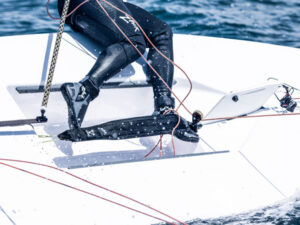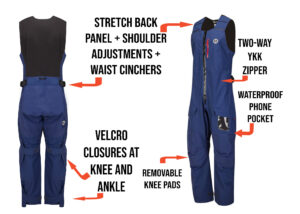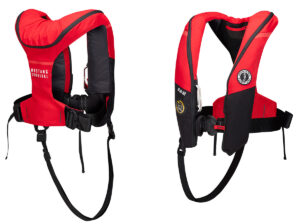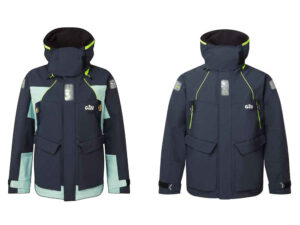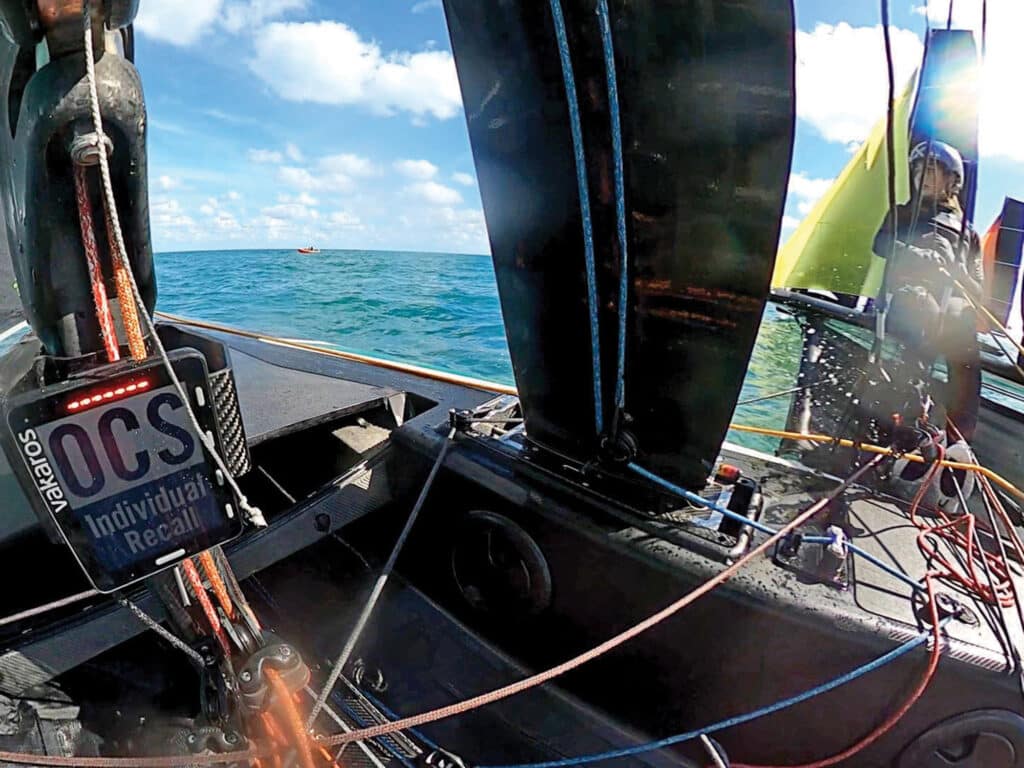
Ask any mark-boat volunteer what irks them most about setting a start pin for a class that allows GPS-based starting devices and chances are the response you’ll get is: “The pinging chaos.” What a pain it is to stream or reset tackle while crews swarm like flies, yelling and banging into each other. Pinging is a modern annoyance for everyone, but the engineers at Vakaros, makers of starting devices that contributed to the problem in the first place, have finally rolled out a solution that could put an end to it.
With its new Atlas2 units flying off the shelf and the companion race-management software getting into the hands of PROs, Vakaros says the stresses of getting—and delivering—a good and fair start are fast becoming a thing of the past. Race committees and marshmallows rejoice.
“[RaceSense] is something we’ve been talking about for a long time, and we’re now at a place where we have the technology ready and the bandwidth to focus on it,” says Vakaros co-founder Jake Keilman. “We’re going from it being something possible to something that will become very common.”
That something is more effectively orchestrating starts using better GPS technology. That means sharper time-and-distance accuracy for the sailors and more-accurate OCS calls for the race committee. The RaceSense platform isn’t all about starts, though. It can essentially manage an entire race from start to finish.
Keilman says it’s a game-changer, which is hard to dispute. Modern times call for modern technology, and that technology is here.
The Atlas2, a compact (4.5-by-3.5-inch) instrument, has all the essential features and then some—timer, compass, heel angle, etc., with a significantly upgraded hardware and battery package that also has been a long time coming.
“We held back on the Atlas2 to get the newer technology,” Keilman says. “We’re now at a place where the GPS accuracy will match or exceed the human eye calling the start line in any situation you could imagine.”
Catamarans, foilers and other high-speed craft breaking the line at 20 knots? Absolutely, says Keilman. They’ve proven as much with test events in Miami this winter with both the M32 Catamaran and 69F classes, which use reaching starts.
Racecourse management once exclusive to the America’s Cup and SailGP has been scaled for the average sailor with the RaceSense and Atlas2 platform, says Vakaros co-founder Todd Wilson.
“There were a number of challenges we had to really think about to solve. One was position accuracy, but the other was communications, which in a lot of ways was the greater challenge. Then there’s the overall user experience—can they interact with the units? Can race committees send messages and other data straight to competitors? Will there be additional hardware that has to be added to the boat?”
The answers are all packed into the diminutive Atlas2. The critical internal compass and sensors are the best they could source for the price, and the battery will last the duration of a three-day regatta without requiring a daily charge.
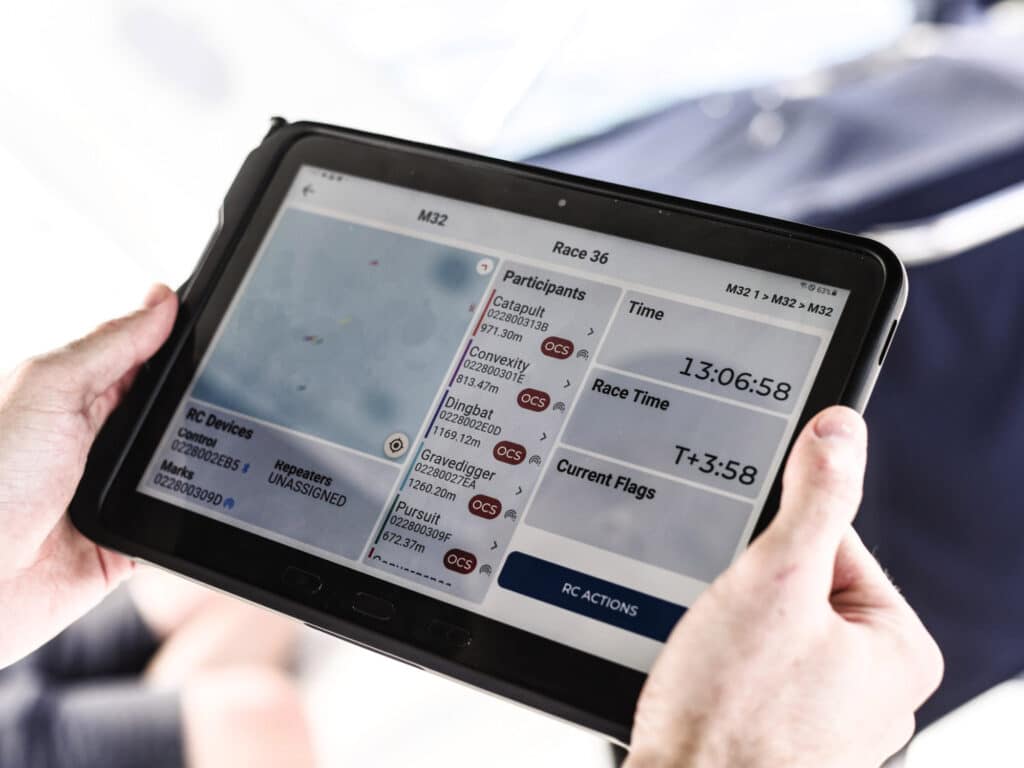
With access to dual-band GPS, they were able to solve the accuracy hurdle. Previous units relied on a single GPS signal, which is subject to anomalies in the atmosphere and can result in errors in the range of 2 meters, Keilman says. “Dual GPS takes us to 50 centimeters of error—or maybe even better under optimal conditions.”
That promise of 50 centimeters of on-the-line accuracy is the tech leap they needed to make it all worthwhile. With the communications challenge sorted, they now have a device that’s a lot more than your old-school starting aid, timer and compass. Race tracking and data logging make post-race debriefs honest discussions.
How does it all work in practicality? The racecourse mesh network would be set up with units marking each end of the starting line. The tablet-based RaceSense app in the race committee’s hands gives the PRO a controlling view of the racecourse. They can verify the course is set, control timing, and send messages to the competitors’ units.
Before the race, each competitor with an Atlas2 automatically checks in with the race committee once in range. (Although the unit does need to be registered with the race committee beforehand.) It’s the equivalent of coming within hail, shouting your sail number, and waving to the committee secretary. A green light on the unit will indicate they’ve joined the race, and then they will receive any messages from the race committee (e.g., start time, course length, mark bearings).
Once connected, the sailor can carry on with pre-race drills. When the race committee initiates a starting sequence, a notice overrides timers and updates previous mark pings. “All the boats get a live sense of where the line is as it moves around during the sequence,” Wilson says. “The competitor does not need to ping or interact with the unit at all; they just get notifications—sounds, lights, messages onscreen to keep everyone in sync.”
With time, distance, boatspeed and angle displayed prominently in big black digits, there should be no reason to be over early. But it happens, and when it does, it’s impossible to miss the red flashing light atop the unit and the big bold OCS on the display.
The RaceSense app shows the race committee which boats are over early (and whether they’ve exonerated their penalty), which theoretically eliminates the practice of ducking for cover behind an exposed boat and getting away with it. The spotter doesn’t need to see you to ding you.
For classes that currently do not allow distance-to-the-line functionality, the units can be configured to be class-compliant, but the race committee can still communicate and alert OCS boats. “We’re adaptable to class rules,” Wilson says.
With real-world winter trials underway and an expanding list of classes and events adopting the RaceSense experiment, it’s in the early days yet in terms of realizing the full potential of the device and software. But the immediate focus for Vakaros is demonstrating to rank-and-file racers the wonders of the starting application. There’s functionality built into the Atlas2 that will enable a fleet to essentially run races without any race committee at all. We’re talking virtual racecourses with boundaries, mark zones and recorded finish orders. “We want it to basically orchestrate the entire race,” he says, “and maybe down the road, we’ll be able to provide advanced tools for umpiring.”
One hurdle for RaceSense implementation across a local fleet or one-design class is the universal buy-in for the Atlas2 units, which retail for $1,100. Resistance within ranks of some classes is to be expected, Wilson says. But he sees another benefit for small fleets where competitors have to occasionally sit out to run the race. “I think this can really make a difference for fleets that don’t have big budgets or aren’t able to bring in a big race committee team. The dream is to be able to push a button on shore, with mark bots running on RaceSense. That way, everyone who wants to sail gets to sail.”
That also means the decline of pinging chaos, he adds. The only ones who will lose out will be those in the gelcoat repair business.

